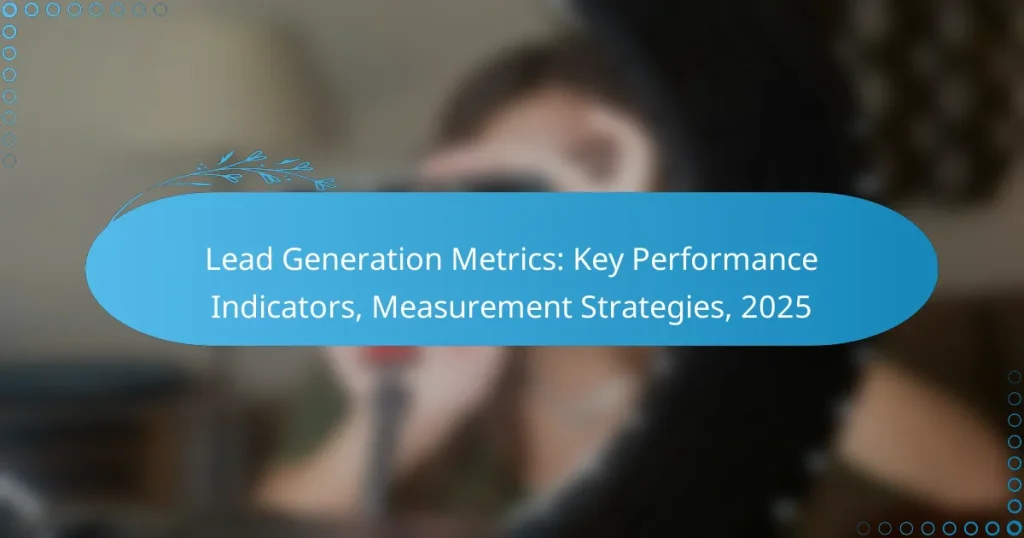As we approach 2025, understanding key lead generation metrics is essential for evaluating the effectiveness of marketing strategies. By focusing on indicators such as conversion rates, cost per lead, and lead quality, businesses can optimize their efforts to attract and convert potential customers more efficiently. Implementing effective measurement strategies will enable organizations to make informed adjustments and enhance their overall lead generation performance.

What are the key lead generation metrics for 2025?
Key lead generation metrics for 2025 focus on evaluating the effectiveness and efficiency of marketing efforts. Understanding these metrics helps businesses optimize their strategies to attract and convert potential customers.
Conversion Rate
The conversion rate measures the percentage of leads that take a desired action, such as making a purchase or signing up for a newsletter. A higher conversion rate indicates effective lead generation and nurturing strategies.
To calculate the conversion rate, divide the number of conversions by the total number of leads, then multiply by 100. For example, if you have 200 leads and 20 conversions, your conversion rate is 10%.
Cost Per Lead
Cost per lead (CPL) quantifies the total expenditure incurred to acquire a single lead. This metric is crucial for assessing the financial efficiency of marketing campaigns.
To calculate CPL, divide the total marketing costs by the number of leads generated. For instance, if you spend $1,000 on a campaign that generates 100 leads, your CPL is $10. Aim to keep CPL within industry benchmarks to ensure profitability.
Lead Quality Score
Lead quality score evaluates the potential of a lead to convert into a customer based on specific criteria, such as demographics and engagement level. A higher score indicates a better fit for your product or service.
To implement a lead scoring system, assign points based on attributes like job title, company size, and interaction history. Regularly review and adjust scoring criteria to reflect changes in your target market and business goals.
Customer Acquisition Cost
Customer acquisition cost (CAC) represents the total cost associated with acquiring a new customer, including marketing and sales expenses. Understanding CAC helps businesses determine the return on investment for their lead generation efforts.
Calculate CAC by dividing total acquisition costs by the number of new customers acquired in a specific period. If you spend $5,000 to gain 50 new customers, your CAC is $100. Keeping CAC low while maintaining quality leads is essential for sustainable growth.
Marketing Qualified Leads
Marketing qualified leads (MQLs) are leads deemed more likely to become customers based on their engagement with your marketing efforts. Identifying MQLs allows sales teams to prioritize leads that show higher potential for conversion.
To classify leads as MQLs, analyze their interactions, such as website visits, content downloads, and email opens. Establish clear criteria for MQL status to ensure alignment between marketing and sales teams, enhancing overall lead management efficiency.

How to measure lead generation performance?
Measuring lead generation performance involves tracking key metrics that indicate the effectiveness of your marketing efforts. Focus on metrics such as conversion rates, cost per lead, and lead quality to gain insights into your strategies and make informed adjustments.
Utilizing CRM Tools
Customer Relationship Management (CRM) tools are essential for tracking lead interactions and managing data. They allow businesses to monitor lead sources, follow-up activities, and conversion rates, providing a comprehensive view of lead performance.
When selecting a CRM, consider features like integration capabilities, user-friendliness, and reporting functionalities. Popular options include Salesforce, HubSpot, and Zoho, which offer various pricing tiers to fit different budgets.
Implementing Analytics Software
Analytics software helps measure the effectiveness of lead generation campaigns by analyzing website traffic, user behavior, and conversion funnels. Tools like Google Analytics provide insights into which channels drive the most leads and how users engage with your content.
To effectively utilize analytics, set up goals and track metrics such as bounce rates, time on site, and conversion paths. Regularly review these metrics to identify trends and optimize your lead generation strategies accordingly.
Conducting A/B Testing
A/B testing involves comparing two versions of a marketing asset to determine which one performs better in generating leads. This method can be applied to landing pages, email campaigns, and ad creatives to optimize conversion rates.
When conducting A/B tests, ensure you test one variable at a time for clear results. Aim for a sample size that provides statistically significant data, and analyze the outcomes to refine your lead generation tactics effectively.

What are effective lead generation strategies?
Effective lead generation strategies are methods used to attract potential customers and convert them into leads. These strategies focus on creating valuable content, engaging with audiences, and nurturing relationships to drive interest in products or services.
Content Marketing
Content marketing involves creating and sharing valuable content to attract and engage a target audience. This can include blog posts, videos, infographics, and eBooks that address the needs and interests of potential customers. By providing useful information, businesses can establish authority and encourage leads to share their contact information.
To maximize effectiveness, focus on SEO to improve visibility and consider using a mix of formats to cater to different preferences. Regularly updating content can also keep your audience engaged and returning for more.
Email Campaigns
Email campaigns are a direct way to reach potential leads by sending targeted messages to their inboxes. These campaigns can include newsletters, promotional offers, or personalized content that resonates with the recipient’s interests. Segmenting your email list based on demographics or behavior can significantly improve engagement rates.
Best practices include crafting compelling subject lines, maintaining a consistent sending schedule, and including clear calls to action. Monitor metrics like open rates and click-through rates to refine your approach over time.
Social Media Engagement
Social media engagement involves interacting with potential leads through platforms like Facebook, LinkedIn, and Twitter. By sharing relevant content, responding to comments, and participating in discussions, businesses can build relationships and increase brand awareness. Engaging content can encourage shares, expanding reach and attracting new leads.
Utilize targeted ads to reach specific demographics and consider hosting live Q&A sessions or polls to foster interaction. Consistency in posting and responding promptly to inquiries can enhance your social media presence.
Webinars and Events
Webinars and events provide opportunities to showcase expertise and connect with potential leads in real-time. These interactive sessions allow businesses to present valuable information while engaging directly with attendees, making it easier to capture leads through registration forms.
To ensure success, promote your webinars through various channels and follow up with participants afterward. Offering incentives, such as exclusive content or discounts, can also encourage sign-ups and participation.

How to set up a lead generation dashboard?
To set up a lead generation dashboard, identify key performance indicators (KPIs) that reflect your goals, and choose a suitable platform for data visualization. This dashboard will help you track and analyze the effectiveness of your lead generation efforts in real-time.
Choosing the Right KPIs
Selecting the right KPIs is crucial for measuring the success of your lead generation strategy. Common KPIs include conversion rates, cost per lead, and lead quality scores. Focus on metrics that align with your business objectives and provide actionable insights.
For example, if your goal is to increase sales, prioritize KPIs that track the number of leads converted into customers. Aim for a balanced mix of quantitative and qualitative metrics to get a comprehensive view of performance.
Integrating Data Sources
Integrating various data sources into your lead generation dashboard allows for a holistic view of your marketing efforts. Consider connecting your CRM, email marketing platform, and social media analytics to gather data from multiple channels. This integration helps in tracking leads from their initial contact to conversion.
Use tools like Zapier or native integrations offered by your dashboard platform to streamline data flow. Ensure that data is updated regularly to maintain accuracy and relevancy in your reporting.
Visualizing Performance Metrics
Effective visualization of performance metrics is essential for quick analysis and decision-making. Use charts, graphs, and tables to represent data clearly and intuitively. For instance, a line graph can effectively show trends in conversion rates over time.
When designing your dashboard, prioritize clarity and simplicity. Avoid cluttering the dashboard with too much information; instead, focus on key metrics that drive your lead generation strategy. Regularly review and adjust visualizations based on stakeholder feedback to enhance usability.

What are the challenges in lead generation?
Lead generation faces several challenges that can hinder effectiveness and efficiency. Key issues include data quality, market competition, and changing consumer behavior, all of which require strategic approaches to overcome.
Data Quality Issues
Data quality is crucial for successful lead generation, as inaccurate or outdated information can lead to wasted resources. Poor data can result from various sources, including manual entry errors, outdated databases, or lack of verification processes.
To improve data quality, businesses should implement regular data audits and cleansing processes. Utilizing automated tools for data collection and verification can also enhance accuracy and reliability.
Market Competition
High competition in many industries makes it challenging to capture and retain leads. As more businesses adopt digital marketing strategies, standing out becomes increasingly difficult.
To navigate market competition, companies should focus on differentiating their value propositions and leveraging unique selling points. Engaging content, targeted advertising, and personalized outreach can help attract potential leads effectively.
Changing Consumer Behavior
Consumer behavior is constantly evolving, influenced by trends, technology, and social factors. Understanding these changes is essential for effective lead generation, as preferences and expectations shift over time.
To adapt to changing consumer behavior, businesses should invest in market research and analytics. Monitoring customer feedback and engagement can provide insights into preferences, allowing for timely adjustments in marketing strategies.


